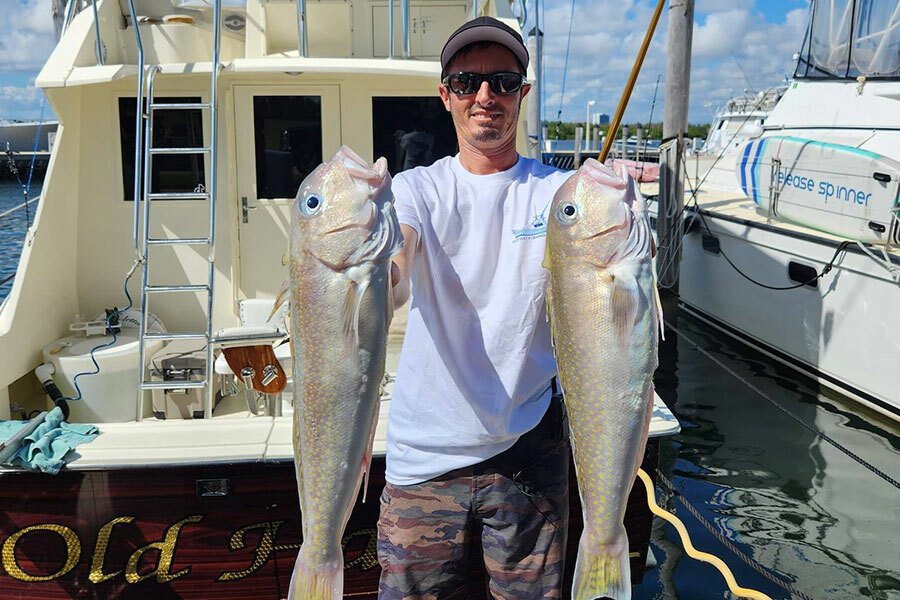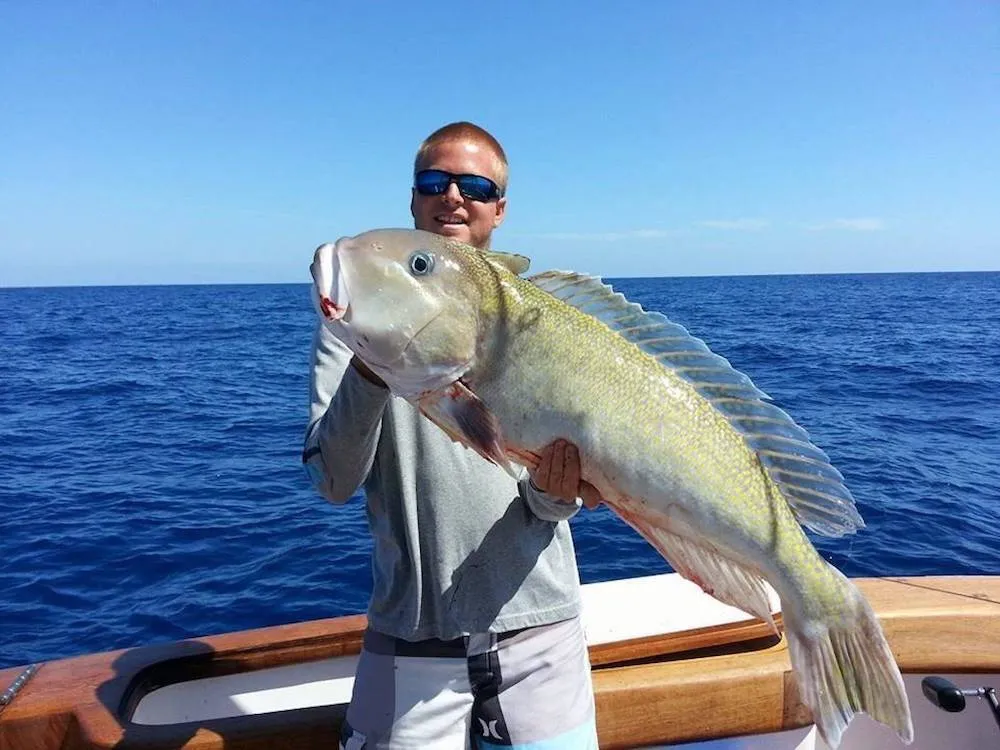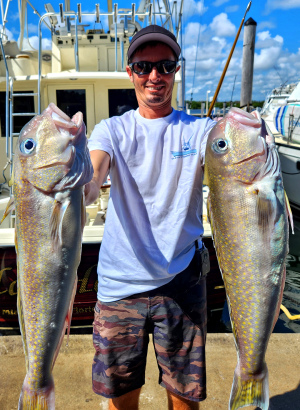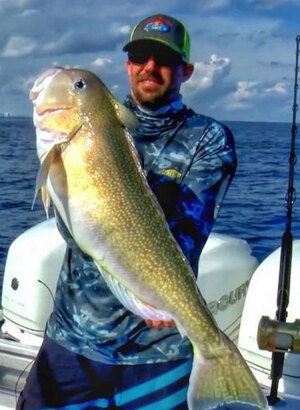The golden tilefish is a marine fish species found in the western Atlantic Ocean, known for its vibrant coloration and unique appearance. Its elongated body and elongated dorsal fin make it a popular commercial and recreational species. They primarily feed on invertebrates and are regulated to prevent overfishing and maintain a sustainable population.

Golden Tilefish -Biology of a Deep Water Delicacy
The golden tilefish (Lopholatilus chamaeleonticeps) is a marine fish species that belongs to the family Malacanthidae. It is predominantly found along the western Atlantic Ocean, ranging from Nova Scotia in Canada down to the Gulf of Mexico and the Caribbean Sea.
Goldens are an attractive species, known for its vibrant coloration and unique appearance. Its body is elongated and somewhat compressed, growing up to 1.2 meters (4 feet) in length and weighing up to 30 kg (66 lbs). The fish's coloration is characterized by a brilliant mix of iridescent blue, green, and gold hues, with a pinkish-white underbelly. The head is large, with a bony crest above the eyes that gives the appearance of a ridge or helmet.
One of the most distinguishing features of the golden tilefish is its elongated dorsal fin, which starts from the head and extends almost the entire length of the body. The first few rays of the dorsal fin are elongated, forming a sail-like structure. The caudal fin is moderately forked, and the anal fin is relatively short.
This tilefish inhabits deep waters, typically residing at depths between 250 to 500 meters (820 to 1,640 feet). They prefer muddy or sandy bottoms near the edge of continental shelves or slopes, where they dig burrows for shelter and protection from predators.
The diet of the golden tilefish primarily consists of invertebrates such as crustaceans, mollusks, and small fish. They use their strong jaws and sharp teeth to crush the shells of their prey.
Golden tilefish are oviparous, with females releasing eggs into the water column, where they are fertilized externally. The eggs are buoyant and float near the surface, eventually hatching into larvae that drift with ocean currents. As the larvae mature, they descend to deeper waters and take up residence in burrows.
These colorful fish are an important commercial and recreational species, valued for its delicious, firm, and mild-flavored white flesh. The fishery is regulated to prevent overfishing and maintain a sustainable population.

Taxonomy of the Golden Tilefish
The taxonomy of the golden tilefish (Lopholatilus chamaeleonticeps) can be broken down as follows:
- Kingdom: Animalia - The golden tilefish belongs to the animal kingdom, which includes all multicellular, eukaryotic organisms that are heterotrophic, meaning they obtain their nutrients by consuming other organisms.
- Phylum: Chordata - This phylum includes animals that possess a notochord, a hollow dorsal nerve cord, pharyngeal slits, an endostyle, and a post-anal tail at some stage during their development.
- Class: Actinopterygii - The golden tilefish is a member of the class Actinopterygii, which consists of ray-finned fishes. These fish have bony spines (rays) supporting their fins, as opposed to the fleshy, lobed fins of the Sarcopterygii (lobe-finned fishes).
- Order: Perciformes - Perciformes is the largest order of vertebrates, comprising over 10,000 species of fish. These fishes have a characteristic dorsal fin structure and, in many cases, a swim bladder.
- Family: Malacanthidae - The golden tilefish belongs to the family Malacanthidae, which consists of tilefishes. These marine fish are found in tropical and subtropical waters and are characterized by their elongated bodies, large heads, and the ability to dig burrows in sandy or muddy substrates.
- Genus: Lopholatilus - The genus Lopholatilus includes the golden tilefish and a few other species. Members of this genus are characterized by their distinctive dorsal fin structure, with the first few rays being elongated and sail-like.
- Species: Lopholatilus chamaeleonticeps - The golden tilefish is a distinct species within the genus Lopholatilus, known for its vibrant coloration and unique appearance.
So, the full scientific classification of the golden tilefish is:
Animalia > Chordata > Actinopterygii > Perciformes > Malacanthidae > Lopholatilus > Lopholatilus chamaeleonticeps
Sporting Quality
- Size and strength: The golden tilefish can grow up to 1.2 meters (4 feet) in length and weigh up to 30 kg (66 lbs). This size and strength make it a formidable opponent for anglers, as it puts up a strong fight when hooked.
- Depth and habitat: Golden tilefish inhabit deep waters, typically residing at depths between 250 to 500 meters (820 to 1,640 feet). Fishing at these depths adds an extra element of challenge, as anglers must use specialized deep-sea fishing gear and techniques, such as electric reels, heavy weights, and braided lines, to reach the fish.
- Technique: Due to the depth at which golden tilefish are found, anglers generally use a technique called deep-drop fishing. This involves lowering baited hooks or rigs to the ocean floor using heavy weights. Once the rig reaches the bottom, the angler carefully lifts the bait off the bottom and waits for a strike. When the fish takes the bait, the angler must reel it in quickly, as tilefish are known to retreat back into their burrows when they feel threatened.
- Rarity and exclusivity: The golden tilefish is not as widely targeted as other game fish species, making it a more exclusive and sought-after catch for anglers looking for a unique experience.
- Taste: The golden tilefish is valued for its firm, white, mild-flavored flesh, which makes it a delicious meal after a successful day of fishing.
It's important to note that regulations and catch limits may be in place to protect the golden tilefish population from overfishing. Anglers should familiarize themselves with local rules and regulations before targeting this species to ensure they are fishing responsibly and sustainably.
Deep dropping for tilefish is not particularly difficult. It just requires attention to some finer points. In The Spread has worked with a couple of south Florida's finest fishing guides and captains to put together a presentation of must know skills to catch golden tilefish.
Predatory Instincts
- Diet: They primarily feed on invertebrates such as crustaceans (shrimps, crabs), mollusks (squid, octopus, clams), and occasionally small fish. Its diet reflects its opportunistic feeding behavior, taking advantage of the available prey in its benthic habitat.
- Strong jaws and sharp teeth: Strong jaws and sharp teeth appoint goldens quite well for crushing the shells of crustaceans and mollusks. These physical adaptations enable the fish to access the soft flesh of its prey, making it a more efficient predator.
- Foraging behavior: Known to actively search for food along the ocean floor, probing the substrate with their snouts and using their barbels (sensory whisker-like structures) to detect prey hidden beneath the sand or mud. They may also dig into the sediment to uncover buried prey.
- Camouflage: The iridescent blue, green, and gold hues of the golden tilefish's body, along with its pinkish-white underbelly, provide an effective camouflage against the backdrop of the deep-sea environment. This coloration helps the fish blend in with its surroundings, making it more difficult for prey to detect its presence.
- Burrow dwelling: Golden tilefish create burrows in sandy or muddy substrates, which serve as shelters and hiding spots. This behavior provides them with a secure base from which to venture out and hunt for food while also offering protection from potential predators.
While the golden tilefish may not be as aggressive or fast-swimming as some other predatory fish species, it is a highly adapted benthic predator that effectively hunts for prey in its deep-sea environment.
When are Where to Fish for Golden Tilefish
Golden tilefish can be found in the western Atlantic Ocean, ranging from Nova Scotia, Canada, down to the Gulf of Mexico and the Caribbean Sea. They inhabit deep waters along the edge of continental shelves or slopes and prefer muddy or sandy bottoms where they can dig burrows for shelter.
- Location: Focus on areas with sandy or muddy bottoms near the edges of continental shelves or slopes, as these are the preferred habitats of golden tilefish. In the United States, productive fishing grounds can be found off the coast of New England, the Mid-Atlantic, and the southeastern states, as well as in the Gulf of Mexico.
- Time of year: While golden tilefish can be caught throughout the year, their activity levels and accessibility may vary depending on the region and water temperature. In the Mid-Atlantic and southeastern states, the warmer months (spring through fall) tend to be more productive, while in the Gulf of Mexico, they can be caught year-round.
- Weather and sea conditions: Calm seas and stable weather conditions are generally more conducive to deep-sea fishing, as they make it easier to maintain a steady position over the fishing grounds and allow for more accurate depth control.
- Bait and tackle: Use bait that mimics the golden tilefish's natural diet, such as squid, cut fish, or shrimp. Heavy-duty deep-sea rods and reels, as well as strong braided lines and circle hooks, are recommended for targeting this strong and deep-dwelling species.
Remember to familiarize yourself with local regulations and catch limits before fishing for golden tilefish to ensure that you are fishing responsibly and sustainably.
Effective Golden Tilefish Fishing Techniques
When fishing for golden tilefish, using effective techniques is essential to maximize your chances of success. Here are some tried-and-tested methods for targeting this deep-dwelling species:
- Rig selection: Use a multi-hook deep-drop rig, which can be outfitted with several hooks (usually 3 to 5) spaced along the leader. This setup increases your chances of catching multiple fish at once and covers a wider area on the ocean floor.
- Bait: Use bait that imitates their natural diet, such as squid, cut fish, or shrimp. You can also use artificial baits like soft plastics or jigs, designed to mimic the appearance and movement of their prey.
- Weights and lights: Attach a heavy weight (1 to 4 lbs) to the bottom of the rig to ensure it reaches the ocean floor and stays in place. Adding a deep-sea fishing light or glow-in-the-dark beads to the rig can attract fish in the dark depths.
- Tackle: Use a heavy-duty deep-sea rod and reel, capable of handling the pressure of fishing at great depths. Strong braided lines (50-100 lbs test) and circle hooks are recommended for targeting golden tilefish, as they provide better hook-ups and reduce the chances of losing the fish during the fight.
- Boat positioning: Maintain accurate boat positioning and control over the drift using your boat's motor or a sea anchor. This will help keep your bait near the bottom and increase your chances of attracting golden tilefish.
- Strike and retrieval: When a fish takes the bait, the rod tip will bend, and the line will start to pull. Engage the reel and set the hook by lifting the rod tip. Reel in quickly, as tilefish may retreat back into their burrows when threatened.
Bonus Video: Golden Tilefish - Bottom Fishing Techniques
Chad Raney, a renowned expert in tilefish fishing, offers expert tactics for locating, controlling current, and locating the fish. His expertise in physics and navigating the ocean floor is crucial for successful tilefish fishing, ensuring minimal risk of getting caught in the muck... View Short Trailer Below or Learn More Here
Tilefish Fishing Gear
Rods and Reels:
Fishing for golden tilefish requires specialized rods and reels capable of handling the challenges of deep-sea fishing. Here is some information on suitable rods and reels for targeting this species:
- Penn Carnage II Boat Casting Rod
- Shimano Terez Saltwater Casting Rod
- Ugly Stik Bigwater Casting Rod
Reels: Choose a high-quality, heavy-duty conventional reel designed for deep-sea fishing. The reel should have a large line capacity to accommodate the heavy braided lines (50-100 lbs test) used for deep-drop fishing. Look for reels with a strong drag system to handle the fight with a large golden tilefish and a high line retrieval rate for bringing the fish up from the depths more efficiently. Electric reels can also be used to make it easier to retrieve heavy weights and fish from deep water.
- Penn Squall Level Wind Reel
- Shimano Talica Two-Speed Lever Drag Reel
- Daiwa Tanacom Electric Reel
Line: Braided line is recommended for deep-drop fishing, as it has a thin diameter and low stretch, which allows for better sensitivity and depth control. Choose a high-quality, abrasion-resistant braided line with a line strength between 50 and 100 lbs test. The thinner diameter helps reduce water resistance and lets the weight reach the bottom more easily.
Leader: Use a monofilament or fluorocarbon leader with a breaking strength similar to the main line. The leader should be around 10 to 15 feet in length and connected to the mainline using a swivel. Monofilament and fluorocarbon leaders offer some stretch, which can help absorb the shock during the fight with a strong fish, and they are less visible underwater, reducing the chances of spooking the fish.
When selecting rods and reels for golden tilefish, prioritize durability, strength, and reliability. Investing in high-quality equipment will not only improve your chances of success but also ensure that your gear can withstand the demands of deep-sea fishing.
- Squid: Squid is a highly effective bait because it is a part of their natural diet, and it is readily available in most tackle shops. Squid is durable and stays on the hook well, making it suitable for deep-drop fishing. Additionally, squid releases a natural scent in the water, which can attract tilefish from a distance.
- Cut fish: Cut pieces of fish, such as barracuda, mackerel, herring, or sardines are very productive. The oily flesh of these fish releases a strong scent in the water, which can be enticing to tilefish. When using cut fish, be sure to secure it firmly to the hook to prevent it from coming off during the descent to the ocean floor.
- Shrimp: Shrimp, both live and dead, can also be used. Shrimp are a part of the tilefish's natural diet and release a scent that can draw them in. When using live shrimp, hook them through the tail or the head, taking care not to damage the vital organs. For dead shrimp, ensure they are fresh and secure them well on the hook.
- Clams: Clams are another option, as they are a part of the tilefish's natural diet. Clams can be used whole or cut into pieces, depending on the size of the clam and the hook being used. The scent released by the clam's flesh can attract tilefish.
Using bait with a strong scent can indeed be beneficial when targeting golden tilefish. The scent helps to draw fish in from a distance and encourages them to investigate the bait. When deep-drop fishing, the scent can be especially important because it provides an additional attractant for fish in an environment with limited visibility. Remember to use fresh bait whenever possible, as it will have a stronger scent and be more appealing to fish.
Fishing Tips for Catching Golden Tilefish
- Depth and location: Found at depths between 250 and 500 meters (820 to 1,640 feet). Focus on areas with sandy or muddy bottoms near the edges of continental shelves or slopes, where they are known to create burrows. Use a depth sounder or GPS to locate suitable areas and monitor water depth while fishing.
- Rig selection: Use a multi-hook deep-drop rig, which can have 3 to 5 hooks spaced along the leader. This setup increases your chances of catching multiple fish at once and covers a wider area on the ocean floor. Attach a heavy weight (1 to 4 lbs) to the bottom of the rig to ensure it reaches the bottom and stays in place. You can also add a deep-sea fishing light or glow-in-the-dark beads to the rig to attract fish in the dark depths.
- Bait: Use bait that resembles the golden tilefish's natural diet, such as squid, cut fish, shrimp, or clams. Fresh bait is preferred, as it releases a stronger scent that can attract tilefish. Secure the bait firmly on the hooks to prevent it from coming off during the descent
- Line management: When deep-drop fishing, it's essential to manage your line properly. Lower the rig slowly and steadily to prevent tangles and ensure it reaches the bottom. Once the rig is on the bottom, carefully lift it a few feet off the ocean floor to make the bait more visible and prevent it from getting snagged.
- Detecting a bite: Pay close attention to your rod tip and line when deep-drop fishing. A bite may be subtle, with the rod tip bending slightly or the line pulling. When you detect a bite, engage the reel and set the hook by lifting the rod tip. Reel in quickly, as tilefish may retreat back into their burrows when threatened.
- Retrieval and landing: Once you've hooked a tile, maintain steady pressure on the fish while reeling it in. If using a conventional reel, be prepared for a physically demanding fight as you reel in the fish from the depths. Use a strong net or gaff to land the fish once it reaches the surface.
By following these tactics and techniques, you'll increase your chances of successfully catching golden tilefish. Remember to familiarize yourself with local regulations and catch limits to ensure you are fishing responsibly and sustainably.
Seth Horne In The Spread, Chief Creator
User Reviews














